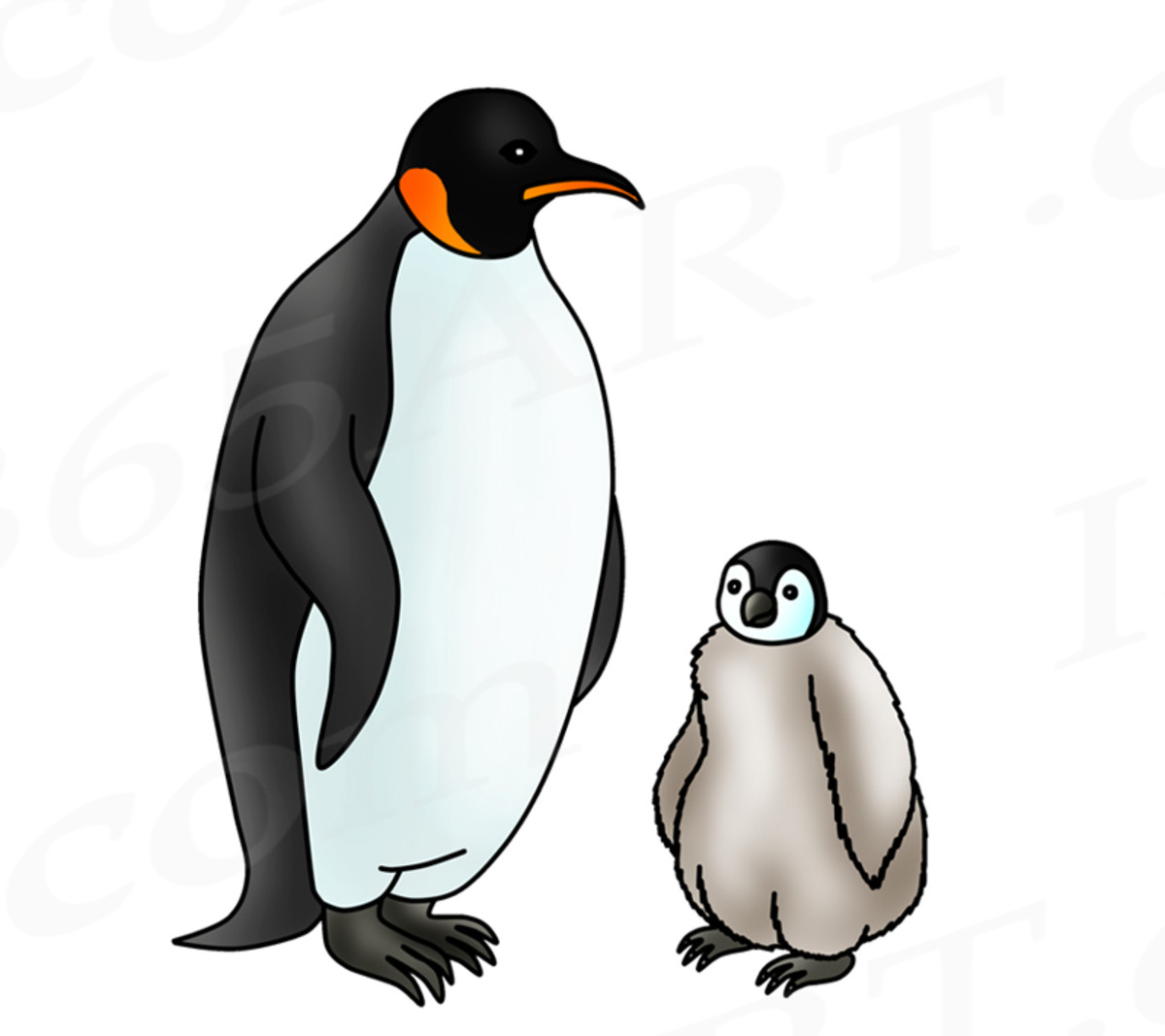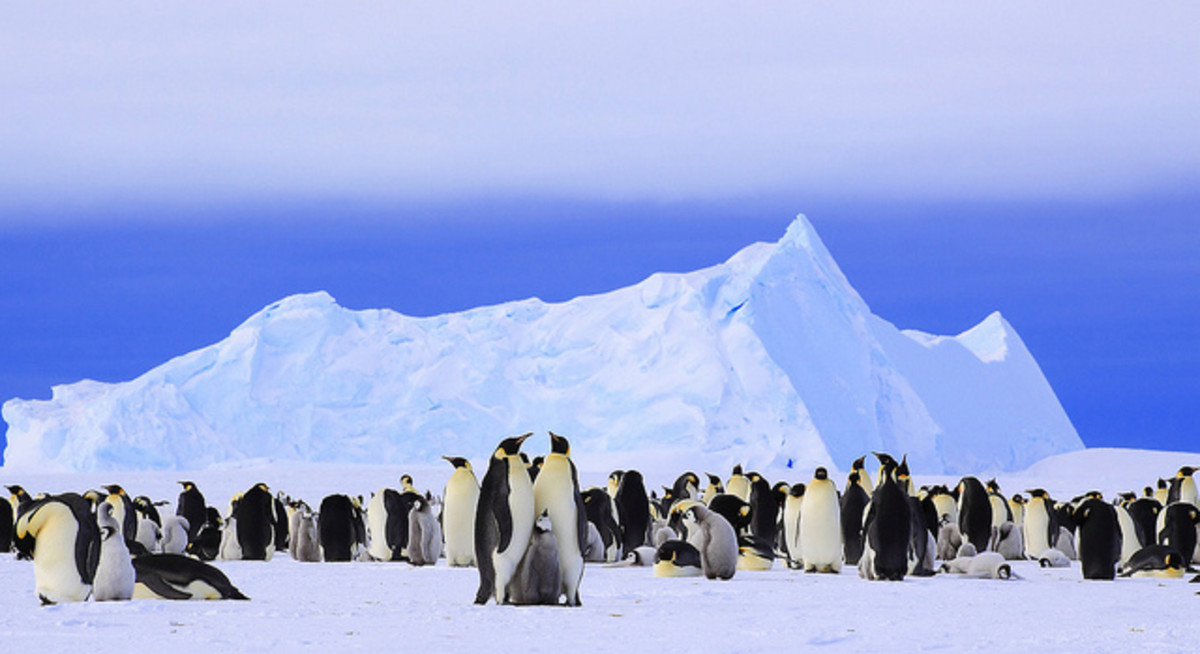Penguins : Are We Saying Hello or Goodbye?
Recent Scientific Observations about the Condition of the Largest Colony of Magellenic Penguins in the World on an Island off the Coast of Argentina
Dee Boersma has been studying the largest colony of Magellanic penguins in the world on the island of Punta Tombo off the coast of Argentina since 1982. Here she takes a census, observes the details of their lives and tags some of them to recort their behavior. The link below the photo will take you to an article that was published at the end of March, 2009 and summarizes the latest information about the conditions of this large colony of penguins.
Dee Boersma With The Penguins She Studies
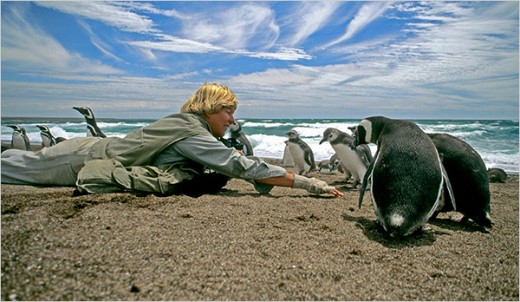
A Conversation with Dee Boersma Penguin Expert
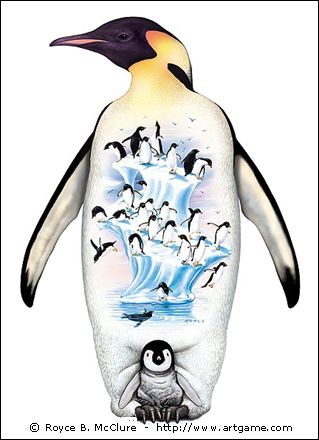
Reactions to Environmental Threats and Animal Suffering
If you're like me, you're finding it hard to keep a smile when you think of the environment. Obviously, it's not just humans who are suffering from global warming and pollution, it's our cousins, the animals who are also suffering. There are many responses to the threats against the environment. One is to try to figure out how to make things better. Another is to feel guilty and try to brush away the guilt. Sometimes, when I see what I call "animal fads" like the current one for penguins and polar bears, I think that they are reactions to keep us from looking at what's really going on. Most of what's in the recent penguin movies is a denial of the problems that are beginning to beset at least some of the species of that tribe. There are a few mentions of the environmental threats, but most of the movie treatments are superficial and cartoonish. It's time movie makers got out of the denial phase and do as much for the animals as recent documentaries have done to establish the reality of global warming.
To make a more general statement, it seems to me that there is an awful lot of mystification in the way the world deals with the environment.
For example, there are all those recommendations aimed at consumers to stop doing things damaging to the environment. I agree that in sum the actions of the huge number of consumers in America do have immense effects on the environment. But take the case of using water. We are often told to use less water. But the other day I was walked by the scene of a street repair and the workers had attached a hose to a nearby hydrant and, guess what, not gallons, but hundreds of gallons of water were spilling onto the street. For what reason, I haven't a clue. Maybe they were trying to flush alligators out of the pipes. Maybe they were just flushing the pipes. But when I see that I think of the phenomenal amount of water (granted, some is recycled, but not all) that is spilled from factories and on farms, I wonder whether the moral imperatives dumped on the consumer are really fair.
But I think the biggest mystification with regard to the environment has to do with how the future is depicted. To make a general statement, there is a strange acceptance of the idea that the looming dangers can best be battled by using the same weapons that created the dangers, that is technology. The most blatant example of this is what can be called the NASA viewpoint. It is NASA's contention (and the science-fiction lovers who run that agency) that the best salvation for the human race is to populate the outer planets and then planets around other stars. This is just plain weird to me. Sure, if you want to dedicate all the wealth and energy of the human race to this purpose for the next ten thousand years, then it makes sense. And the pyramids made a lot of sense to the Pharoahs (but I wonder what the guys hauling the stones thought). But sometimes I wonder whether the game is worth the effort. I don't think we were exactly made, fragile as we are, to travel and live in the boonies of the universe. Sure, Star Treck (a great propaganda set of films for the NASA point of view) made it look easy. Just a few simple gimmicks like a new propulsion system and we can explore the whole universe in a coccoon of earth-like environment. Nothing said about the expense of such a project and what was forgone-what might have been-for realizing it.
I'm not anti-science. But, I suppose, you may call me anti-technology, or anti-engineering point-of-view. Just as some people are anti-art or anti-kicking back, in the sense that they just done by the worth of such pursuits.
Anyway, back to the case of the penguins.
from msnbc
‘Surf’s Up’ can’t quite catch a wave
The penguin fad may end with this uninspired animated mockumentary
Penguins have triumphed at the box office and at the Oscars for two years in a row, so it’s no surprise to find another flock at the multiplex this summer.
Unfortunately, “Surf’s Up,” which features the novelty of surfing penguins, is neither as dramatic as “March of the Penguins” nor as spectacular a singing-dancing vehicle as “Happy Feet.” Expect no Busby Berkeley imitations here.
Indeed, the hero, Cody Maverick, admits early in this feature-length cartoon that he’s not into singing or dancing at all. A native of Shiverpool, Antarctica, he spends his spare time preparing to compete at Pen Gu Island’s annual Big Z Memorial Surf-Off.
Quick factsStarring: Jeff Bridges, Shia LaBeouf, Zooey Deschanel, James Woods, Jon Heder
Director: Ash Brannon, Chris Buck
Run time: 1 hour, 26 minutes
MPAA rating: PG
This works well with Green Day’s “Welcome to Paradise,” which accompanies Cody’s arrival at the island, but the use of Pearl Jam and other groups isn’t as carefully tied to the visuals. Too often it sounds as if the animators left a radio on and accidentally used whatever songs turned up.
Presented as a mockumentary in the “Spinal Tap” tradition, “Surf’s Up” begins with a traditional documentary narration beefing up the history of penguin surfers. Battered old “archival” film clips present the legend of Big Z, a super-surfer who apparently died in a contest many years before.
The characters are often aware that they’re being recorded, and they sometimes try to present a cleaned-up version of themselves. However, the chief villain, Tank Evans (voice by Diedrich Bader), is such a blowhard that he can’t help polishing his many trophies for the cameras. Just the opposite is Cody’s friend, publicity-shy Geek (Jeff Bridges), who wants nothing to do with surfing contests or the sports-addled network SPEN.
getCSS("3053751")
Affleck and Garner play ball, Paris struts one last time, ‘Idols’ rock New York and more.
It’s the single most accomplished episode in the picture, which would be more effective if it relied less on its predictable plot and more on such character-revealing touches. Also strong — and quite funny — is a sequence in which Cody and Geek become obnoxiously obsessive about the proper way to carve a surfboard from scratch.
Too much of the rest of the film is filled with questions that have been answered before they’re posed. Will the lifeguard Lana (Zooey Deschanel) hook up with Cody? Will Geek’s mentoring of Cody bring him back into contact with fellow humans and surfers? Will Cody learn to relax and trust The Force (or something an awful lot like it)?
Matt Damon on PBS: A Scientific View of Penguins
Go see for yourself STUDY IN ANTARCTICA WITH STUDENTS ON ICE
Review of March of the Penguins
Director: Luc Jacquet
Rating: G
Category: Documentary
ALSO! Check out where it ranked in our 2005 Year in Review.
After feeding for months, the Emperor Penguin pops out of the ocean and begins its 70 mile-long march to its breeding ground. Walking single-file, penguins by the thousands, whether they have been there before or not, instinctively march for months with no food or water to where the ice is thick. Once there, the penguins simply pair off, mate, and lay their eggs. Near death, the female penguin carefully transfers the egg to the protection of the male, and marches miles back to the sea to feed. While she is gone, the males huddle together for warmth for months, not budging. Using their feet to cradle the egg off the ice and keeping it covered under their abdominal flaps, they protect the egg through a long and punishing winter, waiting for their mates to return to them.
This is just the beginning of the Emperor Penguins story that is so richly and simply told in the documentary feature “March of the Penguins.” Elegantly written and directed by Luc Jacquet and narrated with grace by actor Morgan Freeman, the film is presented to the audience in a manner as unique as the penguins themselves. Rather than simply photographing the penguins and blandly documenting their behavior, Jacquet treats the audience to a traditional story of life, love, and survival against incalculable odds. By the end of this film you care about what happens to these animals and want them to succeed in their struggle to merely exist.
It’s difficult not to root for the penguins in this film. They are magnificent to look at with the subtlety of their coloring, and even more so for the charm of their mannerisms. Jacquet makes it easy to relate to them, taking any opportunity to show us the humanlike traits they display. They are simple creatures, but there seems to be something more to them that cannot be adequately explained. Just the clumsiness of their bodies and their gait endears them to the audience, and the fact that this hasn’t stopped them from surviving is inspirational.
Jacquet also manages to show not only the beauty of penguins and their story but that of Antarctica as well. The camera lovingly sweeps across the grand vistas of the continent, and even plunges into the icy waters where the penguins spend most of their lives. Throughout the film, one wonders what the crew must have gone through to get some of the shots, but in one of the many great features of this film, as the credits roll, we are shown the crew battling the extreme conditions of their environment and some of what they endured to make this picture.
In the coldest and most desolate place on earth one species has overcome unimaginable odds and not only survived, but thrived in the harsh and unforgiving landscape found at the bottom of the world. The Emperor Penguin of Antarctica is a truly amazing and fascinating species whose story is told so well in “March of the Penguins.” This extraordinary and accomplished piece of filmmaking simultaneously shows the beauty and the brutality of nature as it relates to this remarkable creature and its annual mating ritual, but also finds a way of being one of the most entertaining films all summer.
DVD Features:
The widescreen DVD release of "March of the Penguins" includes an inside look at the filmmaking process of the movie, never-before-seen clips of the penguins diving and feeding, and "8 Ball Bunny," a classic animated short with Bugs Bunny and penguins. We know there's not too much to get excited about, but it's not a bad selection for a documentary.
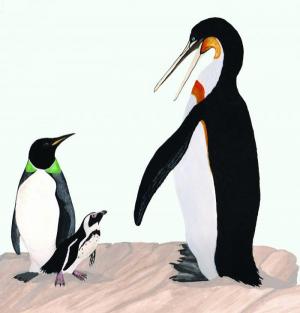
Happy big beak: Giant penguins dwarfed modern versions
Drawing above: Reconstructions of the first Paleogene penguins from equatorial regions, illustrating morphological diversity and size range in present the new early penguin faunas.The late Eocene giant penguin Icadyptes salasi(right) and the middle Eocene Perudyptes devriesi(left) are shown to scale with the only extant penguin inhabiting Peru,Spheniscushumbolti (center).Icadyptes salasi is the first giant penguin known from a complete skull and had an estimated standing height of 1.5m.Perudyptes devriesi is known from one of the most complete skeletons of a more basal part of the penguin lineage. Together these new finds are revolutionizing our understanding of biogeography and timing of diversification in the penguin lineage. (Credit: Art by Kristin Lamm)
Penguins in the ancient past weren't quite the "happy feet" cute animals that are in our movies.
POSTED: 1646 GMT (0046 HKT), June 27, 2007
Story Highlights
• Fossil skulls unearthed in Peru in 2005 are that of two giant penguins• One of the giants lived during one of the warmest periods in Earth's past
• The second giant resembled today's King penguin, standing 2½ to 3 feet tall
• Fossils will help scientists better understand penguin evolution
CNN
(CNN) -- Picture this: A giant penguin with a long, peculiar beak, lounging in the warm sun.
It could be a promotion for the next animated Hollywood movie.
But this big bird is the real thing, its recently discovered fossils providing researchers with several scientific oddities. Not only are the birds extra large by modern standards, they thrived in one of the warmest periods in the past 65 million years.
"We have this ingrained notion of a penguin on an iceberg in a cool sea. But for most of their long history, penguins were in situations of no ice, with maybe crocodiles near them," said Julia Clarke, assistant professor of marine, earth and atmospheric sciences at North Carolina State University in Raleigh, North Carolina.
Clarke, who studies the biodiversity of living birds, and colleagues in Peru and Argentina have described two species of extinct penguins that lived tens of millions of years ago. It was during a time when Earth was a lot warmer than it is today. The fossils were found in Peru in 2005.
The larger of the two new species, Icadyptes salasi, lived about 36 million years ago on the southern coast of Peru. The skull that was discovered includes an intriguing beak that is almost a foot long.
"The texturing on the bone of the beak is unlike any living penguin," said Clarke.
The bird likely had more developed jaw muscles than current penguins, and probably ate large prey, including fish.
The climate of the earth at that time was far different from the icy polar regions and the toastier, tropical middle section we inhabit today.
"The global average temperature was much higher than at present," said Clarke. "And there was relatively little difference between the temperatures at the poles and the equator," she said.
The Earth's first polar icecaps developed about 34 million years ago, after these two penguin species became extinct.
The other newly discovered species, Perudyptes devriesi, is even older, inhabiting the planet 42 million years ago. It resembled one of the largest contemporary penguin species, the King penguin, standing two and a half to three feet tall. Its fossils show that its wings may have looked a little different from the very specialized "paddles" that the wings have become today.
Clarke emphasized that because some penguins on the lower branches of the birds' family tree lived well in warmer temperatures, it would be a colossal mistake to believe that penguins now living could simply adapt to the changes brought about by global warming.
"What happened over millions and millions of years cannot usefully inform us about what may happen over just the next 1,000 years," she said. "The data from these new fossil species cannot be used to argue that warming wouldn't negatively impact living penguins."
These penguin fossils may change understanding of just how and where these flightless birds evolved. Until now, researchers theorized that penguins evolved in high latitudes in New Zealand and Antarctica, eventually moving to warmer areas nearer the equator about ten million years ago. That would have been 24 million years after the transition from very warm temperatures in the Paleocene and Eocene eras to major planetary cooling and the appearance of permanent North and South Poles.
So what does a vertebrate paleontologist think about all the attention penguins are now getting with pop culture hits like "March of the Penguins" and "Happy Feet"?
"Anytime people are motivated to engage and become emotionally connected to the natural world is a good thing for conservation concerns," said Clarke.
The research is published in Proceedings of the National Academy of Sciences. It was funded by the National Geographic Society, and the National Science Foundation Office of International Science and Engineering.
Thanks to CNN. Click to go to original story.



